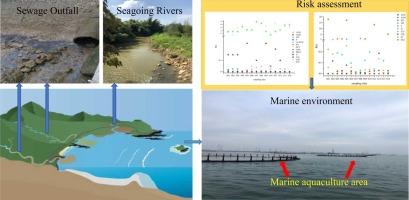Pollution characteristics, sources and ecological risks of steroid hormones in Fangchenggang Bay, South China Sea: Significant impacts of rivers and domestic sewage entering the sea
IF 12.2
1区 环境科学与生态学
Q1 ENGINEERING, ENVIRONMENTAL
引用次数: 0
Abstract
The characteristics, sources and ecological risk of steroid hormone pollution were investigated at 14 stations in Fangchenggang Bay. The results revealed that the detection rate of the steroid hormones in both seawater and sediment was 100%. Twenty-four types of steroid hormones were detected in seawater, and the concentrations ranged from 0.05 (P) to 7.40 ng/L (HCT). Seventeen types of steroid hormones were detected in marine sediments, and the concentrations ranged from 0.02 (SZL) to 0.82 ng/g (E3). The monthly contributions of rivers flowing into the sea and domestic sewage treatment plants were 2178.2 kg and 46.03 kg, respectively. Based on the ecological risk assessment results, MT and EE2 in seawater were considered to be at high risk level, and E2α was at medium risk, whereas the others were considered to be low or no risk levels; in marine sediments, MT, E2αand EE2 were at a high risk level; AED, E1, E2 α, and E3 were at a medium risk level; and the others were at low or no risk levels. The steroid hormones in the monitoring area were mainly affected by land-based pollution. This issue warrants immediate attention from the relevant management departments, and effective preventive measures need to be performed.

求助全文
约1分钟内获得全文
求助全文
来源期刊

Journal of Hazardous Materials
工程技术-工程:环境
CiteScore
25.40
自引率
5.90%
发文量
3059
审稿时长
58 days
期刊介绍:
The Journal of Hazardous Materials serves as a global platform for promoting cutting-edge research in the field of Environmental Science and Engineering. Our publication features a wide range of articles, including full-length research papers, review articles, and perspectives, with the aim of enhancing our understanding of the dangers and risks associated with various materials concerning public health and the environment. It is important to note that the term "environmental contaminants" refers specifically to substances that pose hazardous effects through contamination, while excluding those that do not have such impacts on the environment or human health. Moreover, we emphasize the distinction between wastes and hazardous materials in order to provide further clarity on the scope of the journal. We have a keen interest in exploring specific compounds and microbial agents that have adverse effects on the environment.
 求助内容:
求助内容: 应助结果提醒方式:
应助结果提醒方式:


